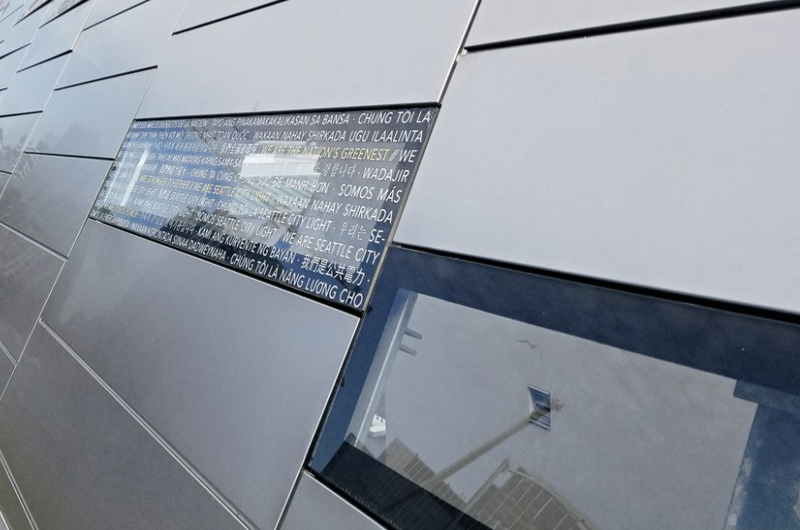Back | Blog posts overview
Stainless in Seattle
17/02/2020
Type 316 stainless steel adorns the face of a new Seattle infrastructure project: an electrical substation that doubles as a public park. As cities grow and global energy demand continues to rise, the new Denny Substation is a welcome glimpse into what a future powered by accessible, sustainable infrastructure might look like.

A closer look at the substation's stainless steel panels. © Seattle City Light
Regardless of the necessity of electricity in modern life, most people do not give much thought to their local electrical substation. Despite the vital service they provide, electrical substations are mostly eyesores: unattractive clusters of wire and blinking grey surfaces, peripheral to the communities they serve. But for some, the rapid growth of 21st-century cities provides an opportunity to improve and reimagine public infrastructure. In this spirit, a new Seattle utility project, the Denny Substation, designed by Seattle architecture firm NBBJ, was destined not for the city outskirts, but the heart of one of its busiest neighborhoods. A glass and stainless steel façade, adjoining green space, and art installations transform the alien-like hive of wire and knobs into a sleek, inviting space. In its double life as both a public utility and park, the Denny Substation aims not only to illuminate Seattle's South Lake Union neighborhood, but also the community's understanding of sustainable energy consumption.
A utility and an amenity
The Denny Substation is more than just a power provider; it is an integrated, community space. The architects and urban planners behind the substation wanted to highlight the idea of growth with both sustainability and neighborhood welfare in mind. A commitment to accessibility, open space, and energy efficiency is reflected in the substation's design, which offers over 4,000 square meters of public area and energy-neutral facilities. The campus surrounding the substation includes an elevated walkway, an outdoor event space, art installations, solar panels, and – last but not least – an off-leash area for dogs.
The substation opened to the public on July 20th of 2019.
Although the initial phase of the project is now completed, an expanded subterranean distribution network is planned for 2020 to increase capacity beyond South Lake Union, into other Seattle neighborhoods, sustaining future population growth.
Bringing urban lighting out of the shadows
The designers of the Denny Substation wanted to highlight sustainability by building net-zero energy facilities, meaning all buildings on site generate the entirety of their own power. Indeed, the substation itself contains on-site solar power, and a heat recycling system that provides 100% of the facility's heat. This pledge to energy-neutrality was no easy feat in a densely populated, city neighborhood.
Typically, it is difficult for a small, low-lying area in a high-rise, urban environment to receive enough direct sunlight for solar power and plant life. That is where the Denny Substation's molybdenum-containing stainless steel walls come in. By sloping inward at an angle, the reflective surface of the stainless steel-clad panels allows enough sunlight to reach the public areas and support plant growth. Furthermore, the use of Type 316 stainless steel itself contributes to sustainability through material longevity, as its corrosion resistance, thanks to the addition of 2% molybdenum, helps protect against both marine and de-icing salts endemic to Seattle. For these reasons, stainless steel is essential to the sustainable design features at the Denny Substation.
In an age when citizens are increasingly distant from the processes that sustain life, the Denny Substation facilitates awareness of energy consumption while highlighting the promise of sustainable growth. Seattle's decision to invite the public to enjoy an ordinarily obscure facility indicates an innovative future for urban infrastructure. By highlighting the unique properties of Type 316 stainless steel, the Denny Substation also signals the centrality of molybdenum to a future of sustainable, community-centered urban growth.
Read more about the project
Back | Blog posts overview

